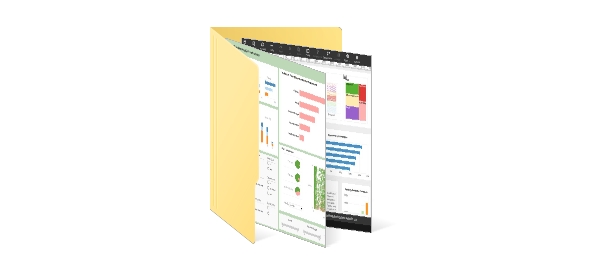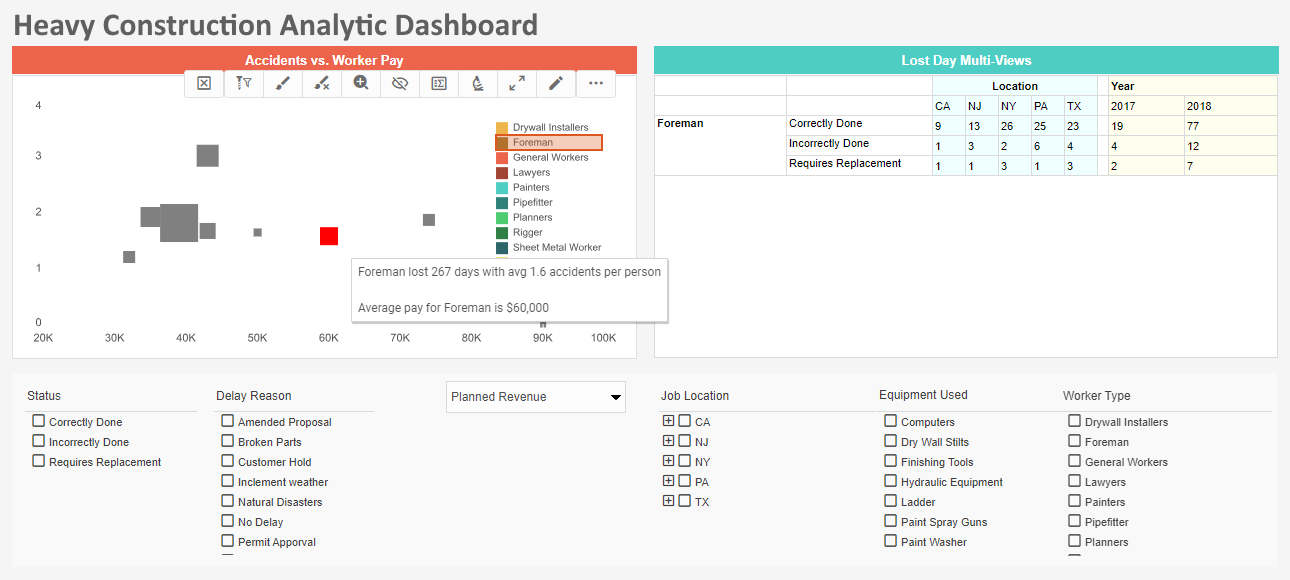What KPIs and Analytics Are Used on Heavy Construction Software Dashboards?
The use of technology has become essential in the field of heavy construction, where projects are large and complex. A key feature of this technology revolution is the use of specialist software dashboards designed for large-scale building projects.
These dashboards simplify operations and show project performance using KPIs and analytics. This article discusses heavy construction software dashboard KPIs and analytics and how they improve project management and decision-making.
| #1 Ranking: Read how InetSoft was rated #1 for user adoption in G2's user survey-based index | Read More |
Types of Heavy Construction Projects
- Highway and Road Construction:
- Description: This involves the construction, expansion, or maintenance of highways, expressways, and local roads.
- Significance: Improved road networks enhance transportation, reduce congestion, and stimulate economic development.
- Bridge Construction:
- Description: Building, repairing, or upgrading bridges that span bodies of water, highways, or other obstacles.
- Significance: Bridges facilitate transportation and connect regions, contributing to economic integration.
- Tunnel Construction:
- Description: Excavating and constructing tunnels for transportation (such as subways) or utility purposes.
- Significance: Tunnels provide efficient transportation options and enable infrastructure development in densely populated areas.
- Airport Construction:
- Description: Building or expanding airports, including runways, terminals, and associated infrastructure.
- Significance: Modern airports are essential for global connectivity and economic development.
- Railway Construction:
- Description: Developing or upgrading railway lines, stations, and associated facilities.
- Significance: Railways are vital for transporting goods and passengers, contributing to sustainable transportation.
- Dam Construction:
- Description: Building dams for water storage, flood control, or hydroelectric power generation.
- Significance: Dams play a crucial role in water resource management, energy production, and environmental protection.
- Pipeline Construction:
- Description: Laying pipelines for the transportation of liquids or gases, such as oil and natural gas.
- Significance: Pipelines are essential for the efficient and safe transport of energy resources.
- Power Plant Construction:
- Description: Building facilities for power generation, including fossil fuel, nuclear, or renewable energy plants.
- Significance: Power plants are critical for meeting energy demands and transitioning to more sustainable energy sources.
- Civic Infrastructure Projects:
- Description: Constructing civic amenities like water treatment plants, sewage systems, and waste disposal facilities.
- Significance: These projects contribute to public health, environmental sustainability, and overall quality of life.
- Commercial and Residential Construction:
- Description: Large-scale construction of commercial buildings, residential complexes, and mixed-use developments.
- Significance: These projects support urbanization, provide housing, and contribute to economic growth.
 |
View the gallery of examples of dashboards and visualizations. |
Project Progress Tracking
Following a construction project's development is essential to guaranteeing its timely completion and resource efficiency. Dashboards for heavy construction software include KPIs that provide current information on the status of projects. Important measurements consist of:
- Completion Percentage: This KPI gives an overview of the project's current status in relation to its whole scope. It helps project managers determine if the work is progressing according to plan.
- Task Completion Rates: A detailed perspective of the project's development is possible by segmenting it into tasks. Tracking task completion rates by individual tasks makes it easier to see bottlenecks and areas that may need more care or resources.
- Timeline Deviation: Monitoring the departure from the schedule facilitates the early detection of delays. Proactive steps to get the project back on track are made possible by this KPI.
Resource Utilization and Allocation
In large-scale building projects, when labor, materials, and equipment are essential, resource efficiency is crucial. This area of analytics offers a thorough rundown of resource management. Important measurements consist of:
- Equipment Downtime: By keeping track of how long heavy equipment is idle for repairs or maintenance, preventative maintenance may be scheduled and unplanned downtime can be minimized.
- Material Consumption Rates: Monitoring material usage in relation to the project schedule aids in inventory control and helps prevent shortages that can cause work to stop.
- Labor Productivity: This KPI evaluates the workforce's effectiveness. Metrics like the quantity of jobs completed by each worker are included, which aids in labor allocation optimization.
Cost Control and Budget Management
In building projects, keeping costs under control is an ongoing concern. Dashboards for heavy construction software provide insights and KPIs to help you closely monitor costs. Important measurements consist of:
- Cost Variance: This KPI provides information on cost overruns or savings by comparing the actual spending to the budgeted amount. It is essential for proactive money handling.
- Budget Allocation: Project managers may find areas where modifications could be necessary by using analytics that indicate how the money is allocated across the different project components.
- Return on Investment (ROI): Determining the return on investment (ROI) of various project components facilitates the process of allocating resources and prioritizing projects.
Safety and Compliance Metrics
In heavy construction, it is essential to provide both a safe working environment and adherence to industry requirements. Dashboards use analytics and KPIs to track and improve safety regulations. Important measurements consist of:
- Incident Rate: An indicator of the project's safety performance is the number of mishaps or safety events per work hour.
- Regulatory Compliance: Analytics that point out areas where compliance may be deficient make it easier to ensure conformity to safety rules and industry standards.
- Training Effectiveness: Evaluating the effectiveness of safety training initiatives using KPIs for decreased incident rates and enhanced safety procedures.
Supply Chain Visibility
Complex supply chains are often a part of large-scale building projects due to their complexity. Transparency into the movement of materials and resources is provided in this sector by KPIs and analytics. Important measurements consist of:
- Supplier Performance: By evaluating a supplier's dependability and effectiveness, you may lower the chance of project delays by ensuring a consistent and timely delivery of goods.
- Inventory Turnover: Monitoring the rate at which materials flow through the supply chain facilitates the optimization of inventory levels and the reduction of holding expenses.
- Lead Time Analysis: Project scheduling may be made more effective by taking into account the time it takes for goods to travel from suppliers to the building site.
Environmental Impact Metrics
The ecological impact of large-scale building projects is being closely examined in an age when environmental consciousness is growing. Environmental issues are addressed by the KPIs and analytics in this area. Important measurements consist of:
- Carbon Footprint: The quantity of greenhouse gas emissions produced by construction operations may be measured, which aids in the implementation of carbon reduction initiatives.
- Waste Generation Rates: Implementing trash reduction and recycling programs is made easier by keeping track of the quantity of waste generated per unit of building activity.
- Energy Efficiency: Finding chances for energy savings is made possible by evaluating how much energy building procedures and equipment use.
 |
Learn about the top 10 features of embedded business intelligence. |
Equipment Health and Maintenance
The success of a project depends on the heavy equipment operating well. By using KPIs and analytics to track equipment health and maintenance plans, you can reduce downtime and guarantee peak performance.
- Maintenance Costs: Monitoring the expenses related to equipment upkeep provide valuable information about the general condition of the gear and facilitates financial planning.
- Predictive Maintenance Effectiveness: Refinement of maintenance schedules and the avoidance of unplanned failures are made possible by analytics that evaluate the predictive maintenance models' accuracy.
- Utilization Rates: It is possible to detect underused assets or possible overcapacity by keeping an eye on the ratio of equipment usage to idle time.
Quality Control Metrics
Long-term durability and customer happiness depend on the quality of the building job. This category's KPIs and statistics are focused on preserving and improving building quality.
- Defect Rates: Monitoring the quantity of flaws or rework required after construction offers information about how well quality control procedures are working.
- Material Compliance: In order to prevent structural difficulties and regulatory challenges, it is essential to make sure that building materials fulfill specified standards and compliance criteria.
- Client Satisfaction Scores: A qualitative indicator of the success and quality of a project may be obtained by using surveys or feedback forms to get input from stakeholders and customers.
Communication and Collaboration Effectiveness
For complicated building projects to be coordinated, effective communication and teamwork are essential. This category's KPIs and analytics evaluate the cohesion of project teams.
- Communication Response Time: Communication bottlenecks may be found by tracking how fast team members reply to messages or requests.
- Collaboration Platform Usage: Understanding the efficacy of communication channels may be gained by examining the use trends of the collaboration tools that are included into the software dashboard.
- Issue Resolution Time: Monitoring the duration of time required to address problems linked to a project aid in evaluating the effectiveness of procedures related to communication and problem-solving.
 |
Read the top 10 reasons for selecting InetSoft as your BI partner. |
Weather Impact Analysis
Large-scale building projects are often prone to difficulties and delays caused by bad weather. Project managers may more effectively plan ahead and minimize any interruptions with the use of weather-related KPIs and data.
- Weather Downtime: Tracking the amount of time that work is put on hold because of bad weather offers valuable information for risk assessment and project scheduling.
- Accuracy of Weather Forecasts: Evaluating weather prediction accuracy facilitates resource allocation and proactive decision-making based on anticipated weather patterns.
- Weather-Related Incidents: Monitoring weather-related events, including accidents or material damage, provide information for risk assessment and reduction.
Stakeholder Engagement Metrics
Heavy construction projects must include stakeholders, such as local communities and regulatory agencies, in order to be successful. This category's KPIs and statistics track how well stakeholder engagement initiatives are working.
- Community Relations Index: Evaluating how the project is seen in the neighborhood helps in pinpointing problem areas and providing solutions.
- Regulatory Compliance Tracking: Ensuring that permissions and regulations are followed guarantees that projects go forward without encountering any legal or regulatory obstacles.
- Public Relations Impact: Understanding the project's public perception and assisting in the development of communication strategies are two benefits of analyzing media coverage and PR initiatives.
Adaptability and Change Management
Unexpected changes often occur throughout construction projects, necessitating flexibility. This category's KPIs and analytics evaluate the project's flexibility and risk management.
- Change Order Response Time: The ability of the project to adjust quickly to changing needs may be evaluated by keeping track of how long it takes to process and execute change orders.
- Risk Mitigation Effectiveness: Examining the project's risk management and mitigation strategies, particularly with regard to those resulting from scope modifications or unforeseen occurrences, offers valuable information about the project's overall resilience.
- Adoption Rates of New Technologies: Monitoring the rates at which new construction techniques and technologies are adopted gives insight into how open a project is to implementing innovations and increasing productivity.

